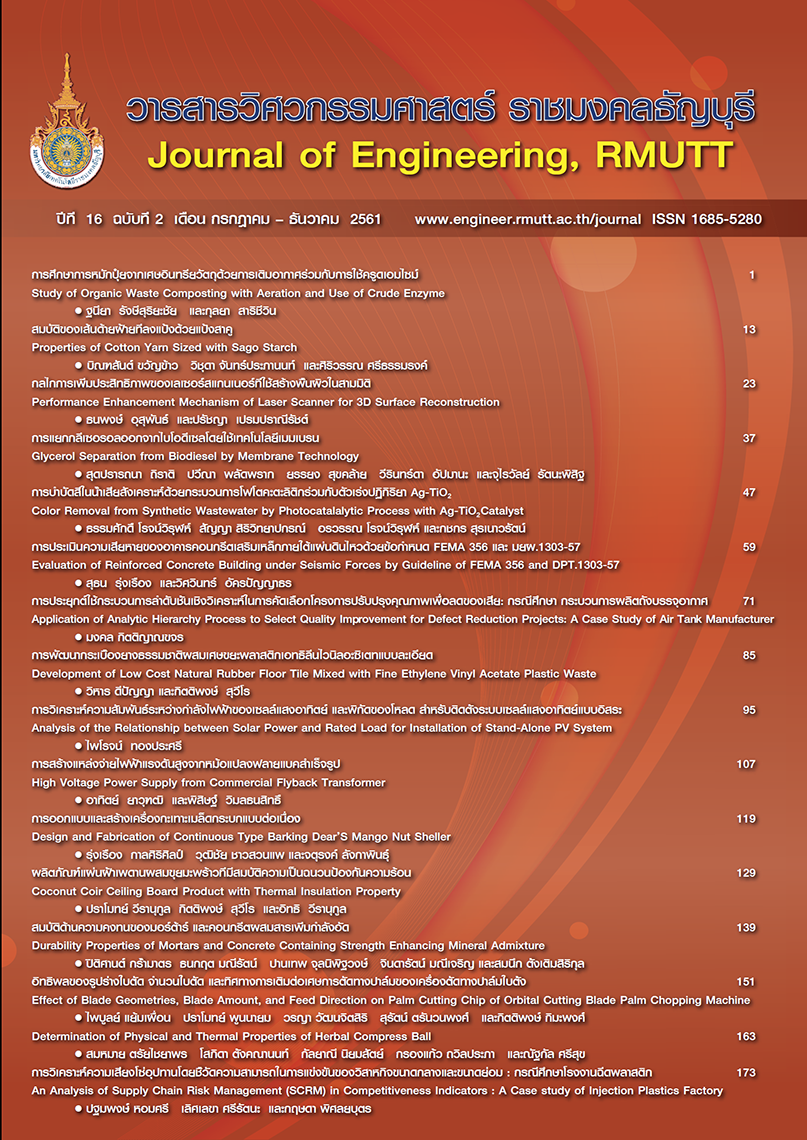การศึกษาการหมักปุ๋ยจากเศษอินทรียวัตถุด้วยการเติมอากาศ ร่วมกับการใช้ครูดเอมไซม์
##plugins.themes.bootstrap3.article.main##
摘要
การศึกษาการหมักปุ๋ยจากเศษอินทรียวัตถุด้วยการเติมอากาศร่วมกับการใช้ครูดเอมไซม์ ได้แก่ ครูดเอมไซม์จากเชื้อเดี่ยว Trichoderma reesei และเชื้อผสมระหว่าง Trichoderma reesei และ Saccharomyces cerevisiae โดยศึกษาคุณลักษณะที่ได้จากการหมักปุ๋ยที่มีการเติมครูดเอมไซม์ผงทั้งสองแบบเปรียบเทียบกัน โดยการแปรเปลี่ยนปริมาณครูดเอมไซม์ที่เติมและปรับเวลาการเติมอากาศที่ 24 ชม. และเปิด-ปิด สลับกัน 6 ชม. จากผลการทดลองพบว่า อุณหภูมิในระหว่างการหมักของถังทั้ง 8 ถัง มีอุณหภูมิที่ใกล้เคียงกัน คืออยู่ในช่วงระหว่าง 28-41 องศาเซลเซียส ซึ่งถือว่าเป็นอุณหภูมิในช่วง Mesophilic ความชื้นในถังหมักปุ๋ยมีค่าอยู่ระหว่างร้อยละ 47-90 ซึ่งความชื้นสูงจะเกิดในช่วงต้นของการทดลองทำให้การหมักเกิดช้าในช่วงแรก เมื่อสิ้นสุดการทดลองค่าความเป็นกรด-ด่าง อยู่ในช่วง 8-9 และฟอสฟอรัสอยู่ในช่วงระหว่างร้อยละ 0.66-1.05 ในด้านคุณลักษณะของปุ๋ยหมักในเรื่องของธาตุอาหาร N, P, K เกือบทุกถังมีค่าเป็นไปตามมาตรฐานปุ๋ยหมัก ค่าอัตราส่วนคาร์บอนต่อไนโตรเจนของปุ๋ยหมักมีเฉพาะถังที่ 1 (มีการเติมอากาศ 24 ชั่วโมง เติมครูดเอนไซม์ 180 กรัม) ที่มีค่าเป็นไปตามมาตรฐานคือ 20:1 ถังที่ 2-8 มีค่าอัตราส่วนคาร์บอนต่อไนโตรเจนประมาณ 30:1 โดยเมื่อพิจารณารูปแบบการเติมอากาศที่ดีที่สุดคือมีการเติมอากาศตลอด 24 ชั่วโมง และถังที่ดีที่สุดคือ ถังที่ 1 ซึ่งมีวัสดุหมักร่วมกับครูดเอมไซม์ผงจากเชื้อเดี่ยวโดยมีการเติมอากาศ 24 ชั่วโมงร่วมกับการเติมครูดเอมไซม์ 180 กรัม
##plugins.themes.bootstrap3.article.details##
The manuscript, information, content, picture and so forth which were published on Frontiers in engineering innovation research has been a copyright of this journal only. There is not allow anyone or any organize to duplicate all content or some document for unethical publication.
参考
Pollution Control Department. Action Plan "Thailand Free of Garbage" according to the "public" guidelines for a year (2016-2017) [Internet]. 2016 [cited 2017 Jan 1]: [about 1 p.]. Available from: http://infofile.pcd.go.th/waste/
ThaiPlans%20without%20Waste.pdf?CFID=2929130&CFTOKEN=49324635 (in Thai)
Srisatit T. Municipal Solid Waste Management Engineering. 1st ed. Bangkok: The Engineering Institute of Thailand under H.M. The King’s Patronage; 2015. (in Thai)
Siwarasak P, Yaowalak T, Jutarat N, Nirun J, Tom M. Crude Enzyme Powder Utilization for Ethanol Fermentation from Pineapple Skins. 7th Conference On Energy Network of Thailand. 2011 May 3-5:13-8. (in Thai)
Siwarasak P, Pajantagate P, Prasertlertart K. Use of Trichoderma reesei RT-P1 Crude Enzyme Power for Ethanol Fermentation of Sweet Sorghum Fresh Stalks. Bioresource Technology. 2012;107:200-4.
Zhang L, Sun X. Effects of Earthworm Casts and Zeolite on the Two-Stage Composting of Green Waste. Waste Management. 2015;39: 119-29.
Karnchanawang S, Suriyanon N. 2011. Household Organic Waste Composting using Bins with different types of passive aeration. Resource, Conservation and Recycling. 2011;55: 548-53.
Saricheewin K, Rangseesuriyachai T. Composting of Organic Waste Using Aeration Tank. Journal of Engineering, RMUTT. 2016;14(1):25-34. (in Thai)
Department of Agriculture. Manual of Organic Fertilizer Analysis. 1st ed. Bangkok: Department of Agriculture; 2008. (in Thai)
Manu, M.K., Kumar, R., Garg, A.. 2017. Performance Assessment of Improved Composting System for Food Waste with Varying Aeration and Use of Microbial Inoculum. Bioresource Technology. 2017;234: 167-77.
Osotspa Y, Wongmaneeroj A, Hongprayun C.Fertilizer for Sustainable Agriculture. 2nd ed. Bangkok: Kasetsart University Press; 2011. (in Thai)
Gaur A.C., Sadasivan K.U., Mathur R.S., Magu S.P. Role of Mesophilic Fungi in Composting. Agricultural Waste. 1982;4:453-60.
Martins O., Dewes T. Loss of nitrogenous compounds during composting of animal wastes. Bioresource Technology. 1992;42: 103-11.
Land Developement Department. Operational Guide: Plant, Fertilizer and Soil Analysis Processes [Internet]. 2010 [cited 2017 Sep 16]: [about 1 p.]. Available from: http://www.ldd.go.th/PMQA/ 2553/Manual/OSD-07.pdf (in Thai)
Chanchampee P. Thermophilic Composting of Food Waste and Farm Residue by Rotary Drum [dissertation]. Chiangmai: Chiangmai University; 1998. (in Thai)
Sánchez C. Lignocellulosic Residues: Biodegradation and Bioconversion by Fungi. Biotechnology Advance. 2009; 27:185-94.
Mohammad N., Zahaagir Alam Md., Nassereldeen A.K., Amimul, A. Effective Composting of Oil Palm Industrial Waste by Filamentous: A review. Resources Conservation and Recycling. 2012;58:69-78.
Zhisheng Y, Hongxun, Z. Ethanol Fermentation of Acid-Hydrolyzed Cellulosic Pyrolysate with Saccharomyces cerevisiae. Bioresource Technology. 2004;93: 199-204.
Rui G., Guoxue L., Tao J., and et al. Effect of aeration rate, C/N ratio and moisture content on the stability and maturity of compost. Bioresource Technology. 2012;112:171-78.

